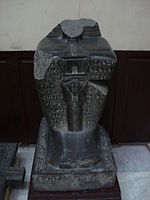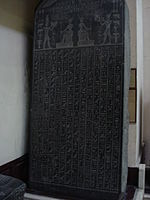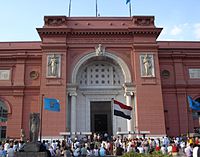Egyptian Museum
This article needs to be updated. (February 2011) |
المتحف المصري | |
 المتحف المصري | |
 | |
| Established | 1902 |
|---|---|
| Location | Cairo, Egypt |
| Type | History museum |
| Collection size | 120,000 items |
| Director | Mohamed Abdel Hamid Shimy |
| Website | www |
The Museum of Egyptian Antiquities, known commonly as the Egyptian Museum or Museum of Cairo, in Cairo, Egypt, is home to an extensive collection of ancient Egyptian antiquities. It has 120,000 items, with a representative amount on display, the remainder in storerooms.
History
The Egyptian Museum of Antiquities contains many important pieces of ancient Egyptian history. It houses the world’s largest collection of Pharaonic antiquities. The Egyptian government established the museum, built in 1835 near the Ezbekeyah Garden and later to the Cairo Citadel. In 1855 Archduke Maximilian of Austria was given all of the artifacts by the Egyptian government; these are now in the Kunsthistorisches Museum, Vienna.
A new museum was established at Boulaq in 1858 in a former warehouse, following the foundation of the new Antiquities Department under the direction of Auguste Mariette. The building lay on the bank of the Nile River, and in 1878 it suffered significant damage in a flood of the Nile River. In 1892, the collections were moved to a former royal palace, in the Giza district of Cairo. They remained there until 1902 when they were moved, for the last time, to the current museum in Tahrir Square.
During the Egyptian Revolution of 2011, the museum was broken into, and two mummies were reportedly destroyed.[1][2] Several artifacts were also shown to have been damaged.[3] Around 50 objects were lost.[4] Since then 25 objects have been found. Those that were restored were put on display in September 2013 in an exhibition entitled Damaged and Restored. Among the displayed artifacts are two statues of King Tutankhamen made of cedar wood and covered with gold, a statue of King Akhenaton, Ushabtis statues that belonged to the Nubian kings, a mummy of a child and a small plychrome glass vase.[5]
Interior design
There are two main floors in the museum, the ground floor and the first floor. On the ground floor there is an extensive collection of papyrus and coins used in the Ancient world. The numerous pieces of papyrus are generally small fragments, due to their decay over the past two millennia. Several languages are found on these pieces, including Greek, Latin, Arabic, and ancient Egyptian. The coins found on this floor are made of many different metals, including gold, silver, and bronze. The coins are not only Egyptian, but also Greek, Roman, and Islamic. This has helped historians research the history of Ancient Egyptian trade.
Also on the ground floor are artifacts from the New Kingdom, the time period between 1550 and 1069 BC. These artifacts are generally larger than items created in earlier centuries. Those items include statues, tables, and coffins (sarcophagi).
On the first floor there are artifacts from the final two dynasties of Egypt, including items from the tombs of the Pharaohs Thutmosis III, Thutmosis IV, Amenophis II, Hatshepsut, and the courtier Maiherpri, as well as many artifacts from the Valley of the Kings, in particular the material from the intact tombs of Tutankhamun and Psusennes I. Two special rooms contain a number of mummies of kings and other royal family members of the New Kingdom.

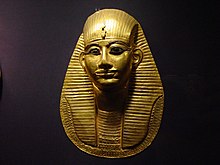
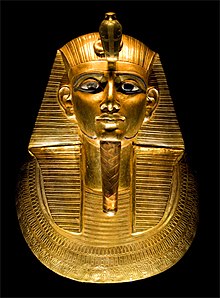
Gallery
See also
- Egyptian Museum of Turin
- Egyptian Museum of Berlin
- Grand Egyptian Museum
- List of museums with major collections of Egyptian antiquities
References
- ^ "Looters destroy mummies during Egypt protests". ABC News. 29 January 2011. Retrieved 29 January 2011.
- ^ "Vandals ravage Egyptian Museum, break mummies". Al-Masry Al-Youm. Retrieved 30 January 2011.[dead link]
- ^ "Statues of Tutankhamun damaged/stolen from the Egyptian Museum". The Eloquent Peasant. Retrieved 30 January 2011.
- ^ "Mummies set on fire as looters raid Egyptian museum - video - Channel 4 News". Channel4.com. 28 August 2013. Retrieved 8 January 2014.
- ^ "Egyptian Museum exhibit puts spotlight on restored artefacts". Daily News Egypt. Retrieved 8 January 2014.
Further reading
- Brier, Bob (1999). The Murder of Tutankhamen: A True Story. ISBN 0-425-16689-9.
- Montet, Pierre (1968). Lives of the Pharaohs. World Publishing Company.
- Wafaa El-Saddik. The Egyptian Museum. Museum International. (Vol. 57, No.1-2, 2005).
- Egyptian Treasures from the Egyptian Museum in Cairo, Francesco Tiradritti, editor, Araldo De Luca, photographer. 1999, New York: Abrams ISBN 0-8109-3276-8. Also published, with variant titles, in Italy and the UK. Reviews US ed.
External links
- Egyptian Museum official website
- Photographic archive of Art and Architecture
- The Cairo Museum
- Gallery of Items in the Egyptian Museum
Children`s Museum The Children’s Museum is divided into 6 sections and includes a workshop. Each of the first five halls is devoted to a different aspect of Ancient Egyptian history – everyday life along the Nile, writing, kings and their families, and religious beliefs, about the afterlife and the many gods and goddess who were worshipped in the country. Our young visitors’ tour ends in a beautiful workshop, equipped with LEGO, where they can express their impressions of the displays and react to what they have experienced. Through their (re)creations, we will be able to judge just how much the museum experience has meant to them and to what extent they have internalized what they have seen. Children may listen and forget, see and understand, work and learn.
The purpose of the Children’s Museum is twofold. We aim to help Egyptian children learn about themselves and their civilization’s distinguished history, and to gain an understanding of what it means to be Egyptian. Additionally, we will provide non-Egyptian children from all over the world with a window on Egyptian history, and how our history and culture has impacted their own. Inside the Children’s Museum, children can satisfy their curiosity and obtain information about history, art, and culture in general, through a multi-disciplinary approach. The LEGO creations will make the original pieces come alive, and help children to understand the soul infusing the past and inspiring the future. In the workshop children will express their individual creative talents and learn to appreciate and understand art through the pieces they create. The ultimate goal of the Children’s Museum and the educational department is to stimulate and develop each young visitor’s creativity, the most important aspect of every child’s education. An exceptional feature of the Children’s Museum is our program geared to children with special needs. Programs for blind, deaf, and mentally handicapped children ensure that the museum is a place where all Egyptian children can come to learn about Egyptian history and civilization in an interactive way. Preservation of history and appreciation of it is a critical part of any culture’s progress. Understanding our history gives us a sense of belonging, and will enable us to uphold our traditions and culture, essential for building a better future. The civilization of ancient Egypt impressed the world with its ingenuity, charm, and beauty. One of the oldest civilizations in the world, it is justly credited with the invention of much of what we hold dear today—art, architecture, science, and traditions. Ancient Egypt’s gifts to the world include the pyramids; their awesome size and aesthetic simplicity are of historical and symbolic importance for everyone. Temples like those of Karnak, Luxor, and Abu Simbel, possess sophisticated architectural elements and extraordinary reliefs. The royal tombs and the tombs of the nobles with their colorful wall decoration give us a wealth of information about ancient Egyptian beliefs and funerary practices, and about their daily life. Quite evidently the ancient Egyptians loved life and imagined that there would be a second life after death similar to one they experienced on earth while alive. This explains why they covered the walls of their tombs with scenes depicting themselves in the world around them. We see them singing and making music, meeting friends and family, and enjoying social gatherings. We also see farmers at work in the fields, and carpenters carving statues in their workshops, and many artisans and officials at work. In addition, the tombs were amply







